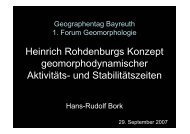Chapter 14 - Limitations on Predictive Modeling in Geomorphology ...
Chapter 14 - Limitations on Predictive Modeling in Geomorphology ...
Chapter 14 - Limitations on Predictive Modeling in Geomorphology ...
You also want an ePaper? Increase the reach of your titles
YUMPU automatically turns print PDFs into web optimized ePapers that Google loves.
LIMITATIONS ON PREDICTIVE MODELING 339<br />
Bedload transport is an example of a specific process that has been studied extensively<br />
<strong>in</strong> the laboratory and that also plays an important role <strong>in</strong> the evoluti<strong>on</strong> of many<br />
geomorphic systems. Over a period of many decades, small-scale experiments <strong>in</strong> flumes<br />
have been carried out and semiempirical and empirical models developed and ref<strong>in</strong>ed <strong>on</strong><br />
the basis of those experiments (ASCE 1975). These models reflect properties such as gra<strong>in</strong><br />
size and surface slope that are underly<strong>in</strong>g determ<strong>in</strong>ants of the physical behavior of the<br />
system. For example, the Meyer-Peter formula can be written (Meyer-Peter and Muller<br />
1948) (<strong>in</strong> SI units) as<br />
2/ 3<br />
q<br />
d<br />
50<br />
S qs<br />
= 17 + 0.4<br />
d<br />
where q s and q are, respectively, sediment and water discharge <strong>in</strong> kg m -1 s -1 , S is the local<br />
slope, and d 50 is the median gra<strong>in</strong> size of the bed material <strong>in</strong> meters. Other models or<br />
'formulas' are expressed directly <strong>in</strong> terms of bed shear stress. Although empirical, these<br />
expressi<strong>on</strong>s are derived from experiments where the <strong>in</strong>dependent variables are<br />
well-c<strong>on</strong>trolled. The form of these equati<strong>on</strong>s is therefore directly c<strong>on</strong>nected to measured<br />
physical behavior under specific experimental c<strong>on</strong>diti<strong>on</strong>s. Figure <str<strong>on</strong>g>14</str<strong>on</strong>g>.1 shows the tightly<br />
clustered experimental results up<strong>on</strong> which the Meyer-Peter formula is based.<br />
When the predicti<strong>on</strong>s of formulae due to different authors are compared, however,<br />
agreement between them is typically poor. Figure <str<strong>on</strong>g>14</str<strong>on</strong>g>.2 shows predicti<strong>on</strong>s of bedload<br />
transport rates based up<strong>on</strong> a number of well-known transport equati<strong>on</strong>s. These curves<br />
were derived under diverse experimental c<strong>on</strong>diti<strong>on</strong>s, and experimental variability may<br />
account for some of the differences <strong>in</strong> predicti<strong>on</strong> shown <strong>in</strong> the figure. However, the<br />
transport equati<strong>on</strong>s illustrated are <strong>in</strong>tended to be applicable for a range of gra<strong>in</strong> sizes from<br />
medium sand to granules. It thus seems fair to make a general comparis<strong>on</strong>, as shown <strong>in</strong><br />
Figure <str<strong>on</strong>g>14</str<strong>on</strong>g>.2, of the transport rates predicted by these equati<strong>on</strong>s. This comparis<strong>on</strong> is based<br />
up<strong>on</strong> results of a comprehensive review of sedimentati<strong>on</strong> sp<strong>on</strong>sored by the American<br />
Society of Civil eng<strong>in</strong>eers (ASCE 1975). Variati<strong>on</strong> over several orders of magnitude<br />
between predicti<strong>on</strong>s for different models suggests that applicati<strong>on</strong> of such formulas to<br />
large-scale geomorphic systems, where local c<strong>on</strong>diti<strong>on</strong>s are often poorly known, will<br />
result <strong>in</strong> significant uncerta<strong>in</strong>ty.<br />
In fluvial problems, empirical rat<strong>in</strong>g curves that bypass any reference to important<br />
underly<strong>in</strong>g physical variables (gra<strong>in</strong> size, shear stress, etc.) have often been used <strong>in</strong><br />
practice. River transport of suspended and c<strong>on</strong>tact load can be described by power-law<br />
rat<strong>in</strong>g curves that relate transport rate to total discharge (ASCE 1975; Richards 1982).<br />
Rat<strong>in</strong>g curves are also comm<strong>on</strong>ly used to estimate reservoir sedimentati<strong>on</strong> (S<strong>in</strong>gh and<br />
Durgunoglu 1992) and soil erosi<strong>on</strong> (Wischmeier 1976). Such rat<strong>in</strong>g curves do not reflect<br />
underly<strong>in</strong>g small-scale properties of sediment transport, but are keyed to measurable<br />
large-scale properties such as total discharge and average slope.<br />
These examples reflect eng<strong>in</strong>eer<strong>in</strong>g attempts to make predicti<strong>on</strong>s of geomorphic<br />
processes. Such attempts may seem crude by the standards of scientific geomorphology,<br />
but geomorphic predicti<strong>on</strong> is <strong>in</strong> practice nearly always based <strong>on</strong> empiricism. This is partly<br />
due to immaturity of the scientific basis of geomorphology, but it also reflects the fact that<br />
complex systems such as those characteristic of geomorphology tend to be resistant to<br />
reducti<strong>on</strong>ism. Because of its overwhelm<strong>in</strong>g success <strong>in</strong> physics, <strong>on</strong>e is accustomed to<br />
2 / 3<br />
50<br />
,








